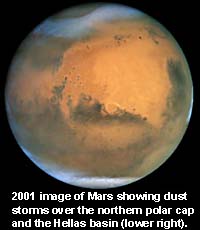AstroCappella: HST Bop!
Historical connection
Astronomy -- the careful observation of objects in the sky leading to deeper insight about the world around us -- has been part of the human experience for as long as organized society has existed. For nearly that entire time, as the study of the sky changed and grew from a tool to predict the best time to plant and harvest, to a way of divining the futures of kingdoms and individuals (astrology -- very unsuccessful and false), to a part of a well-understood physical picture of matter and energy, observations of the sky were made with the naked eye.
The Renaissance
 The science of astronomy took a great leap forward when Galileo first
turned a telescope on the skies. In fact, Western culture as a whole was
forced into an irreversible and major change in its view of the
Universe. Before Galileo's discoveries, the accepted model of the
universe was an Earth-centered, or Geocentric one, in which the Sun, Moon
and planets were perfect spheres in circular orbits about the Earth. But
Galileo saw things with the aid of his telescope that contradicted this
view. His observations of mountains on the Moon, four Moons in orbit
about the planet Jupiter, and dark spots (sunspots) on the Sun, instead
supported an obscure model of the universe put forth in 1543 by
Copernicus, in which the Earth and planets were in orbit about the Sun --
the daily apparent motion of the sky about the Earth was due only to the
Earth's rotation.
The science of astronomy took a great leap forward when Galileo first
turned a telescope on the skies. In fact, Western culture as a whole was
forced into an irreversible and major change in its view of the
Universe. Before Galileo's discoveries, the accepted model of the
universe was an Earth-centered, or Geocentric one, in which the Sun, Moon
and planets were perfect spheres in circular orbits about the Earth. But
Galileo saw things with the aid of his telescope that contradicted this
view. His observations of mountains on the Moon, four Moons in orbit
about the planet Jupiter, and dark spots (sunspots) on the Sun, instead
supported an obscure model of the universe put forth in 1543 by
Copernicus, in which the Earth and planets were in orbit about the Sun --
the daily apparent motion of the sky about the Earth was due only to the
Earth's rotation. Around the same time, Johannes Kepler (1571-1630) put forth laws of planetary motion based on many years of careful observations, that also placed the Sun at the center of the Solar System.
In 1687, Sir Isaac Newton made the crucial connection that a single force, gravity, was responsible for the motion of objects on Earth and in the Solar System. All three of Kepler's Laws were empirical and Newton made a great leap by proving that these laws were a direct result of the (physical) law of gravitation. Newton unified falling apples and orbiting Moons with his Universal Law of Gravitation, and laid the foundation for a branch of physics known as mechanics.
Galileo's telescope, and the others like it that were soon built and used by other astronomers, represented a kind of "quantum leap" in optical astronomy. Where for thousands of years the planets looked like specks of light in the sky, suddenly they could be resolved into disks, with rings (Saturn) and surface storms (Jupiter and Mars). Many new and unexpected things greeted astronomers as they turned their telescopes skyward, and the scientists were kept very busy trying to explain them. Astronomical observations led to crucial theoretical discoveries in physics and chemistry. New understandings in physics and chemistry in turn led to clearer interpretations of astronomical phenomena.
Such "quantum leaps" -- isolated events in the history of science where our image of the universe and our place in it change abruptly -- are very rare and special. For the most part, science progresses in a fairly regular fashion, with an accepted theoretical interpretation driving the types of observations that are made and conclusions that are drawn. Before the heliocentric model of the solar system was accepted, astronomical observations were made with the assumption that all orbits (the Sun's, the Moon's and the planets') were perfect circles. When small deviations in the predicted and measured positions of the planets crept in, the accepted practice was to imagine another circle upon the larger circle giving rise to the difference. This was known as an epicycle. The combination of Galileo's telescope, Kepler's empirical laws of planetary motion, and Newton's ability to link planetary motion with terrestrial physics suddenly transformed our picture of the universe. We now had Newton's theory of gravity to explain and predict the motions of the planets. New experiments could be devised to test these laws, and the application of the theory of gravity to observations could give new interpretations to their nature.
Edwin Hubble
 Edwin Hubble will certainly be remembered as one of the most important
figures in modern astronomy, and he also ushered in a quantum leap in our
vision of the universe. A lawyer by training, he felt a strong calling to
be an astronomer. Almost as soon as he was finished his study of the law,
he returned to school at the University of Chicago where he got a PhD in
astronomy, and became a careful observer. He then started working at the
Wilson Observatory, where he had at his disposal the two largest
telescopes of the day, a 60-inch and a 100-inch telescope. He was very
interested in a burning question of the time (late 1920's through 1930's),
namely "what is the nature of the 'spiral nebulae'?" Spiral nebulae show
a spiral structure through a telescope, and also a diffuse character, like
the Orion nebula. Some felt they were a special class of nebulae within
the Milky Way galaxy, while others thought they were "island universes,"
entire galaxies themselves. Hubble was intensely interested in all
aspects of these objects. He devised a classification scheme which is
still used today. But his most important contributions started to flow
once he discovered Cepheid variables in 3 spiral nebulae.
Edwin Hubble will certainly be remembered as one of the most important
figures in modern astronomy, and he also ushered in a quantum leap in our
vision of the universe. A lawyer by training, he felt a strong calling to
be an astronomer. Almost as soon as he was finished his study of the law,
he returned to school at the University of Chicago where he got a PhD in
astronomy, and became a careful observer. He then started working at the
Wilson Observatory, where he had at his disposal the two largest
telescopes of the day, a 60-inch and a 100-inch telescope. He was very
interested in a burning question of the time (late 1920's through 1930's),
namely "what is the nature of the 'spiral nebulae'?" Spiral nebulae show
a spiral structure through a telescope, and also a diffuse character, like
the Orion nebula. Some felt they were a special class of nebulae within
the Milky Way galaxy, while others thought they were "island universes,"
entire galaxies themselves. Hubble was intensely interested in all
aspects of these objects. He devised a classification scheme which is
still used today. But his most important contributions started to flow
once he discovered Cepheid variables in 3 spiral nebulae. Cepheid variables are very special stars. The internal engines of these stars heat the outer layers, which expand as a result, making the star appear brighter to an observer. As the outer layers expand they cool, and sink back toward the surface of the star, where the internal engine in the star again heats them. As the layers expand and contract in a rhythmic fashion, the star gets brighter and dimmer in a periodic fashion, with a very distictive shape in the plot of intensity versus time. Cepheids are all undergoing the same physical process, which can be characterized by a simple period-luminosity relation. That means that the brighter the star actually is, the longer the period of rising and falling of the outer layers. This is incredibly useful to astronomers, who can measure the period of a Cepheid variable and deduce its actual brightness. Using its absolute and apparent brightnesses, astronomers can easily calculate its distance. There are very few ways in which distance can be measured. Cepheid variables are valuable distance indicators.
Cepheids and Our Place in the Universe
When Hubble discovered Cepheids in the spiral nebulae he immediately performed observations to measure the distances to these stars, and thus to the spiral nebulae. He found that they were indeed extremely far away, much further than anything in the Milky Way galaxy. The universe was populated with individual galaxies, scattered apparently randomly, to a distance as far as could be detected with the Wilson Observatory telescopes. Think of the drastic changes that astronomy has forced on our view of the universe and our place in it. From humanity's earliest interpretations of the geocentric universe, with the Earth stationary and everything else in orbit about it, astronomy has led us away from this picture with each step. First, it was discovered that the Sun was the center of gravity of the Solar system; later, that the Sun was not at the center of the Milky Way, but orbited about its center; and finally that the Milky Way was but one of countless galaxies in what seemed to be an infinite universe. That most recent step away from the center was taken with the work of Hubble. But he didn't stop there.The Expansion of the Universe
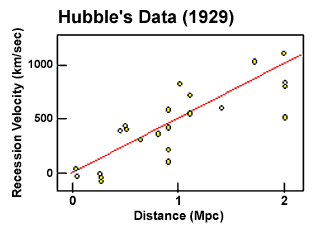 At Mt. Wilson, Hubble began photographing as many galaxies as he could,
and in 1929 discovered a relation between the radial velocities of
galaxies and their distance from us. The further a galaxy from Earth, the
faster it was speeding away from us. The most straightforward
interpretation of this result is that the universe is expanding as the
result of an initial "birth event", now known as the Big Bang. Up until
this time, when people speculated on the origin of the universe, it was a
discussion of faith or philosophy. Edwin Hubble discovered a simple
relation that became the first observable evidence with ramifications on
the birth of everything. Today there is an entire branch of astronomy
dedicated to unraveling the secrets of the first moments of the universe.
At Mt. Wilson, Hubble began photographing as many galaxies as he could,
and in 1929 discovered a relation between the radial velocities of
galaxies and their distance from us. The further a galaxy from Earth, the
faster it was speeding away from us. The most straightforward
interpretation of this result is that the universe is expanding as the
result of an initial "birth event", now known as the Big Bang. Up until
this time, when people speculated on the origin of the universe, it was a
discussion of faith or philosophy. Edwin Hubble discovered a simple
relation that became the first observable evidence with ramifications on
the birth of everything. Today there is an entire branch of astronomy
dedicated to unraveling the secrets of the first moments of the universe.
It is now accepted that observational evidence indicates the universe is expanding, but just how fast is it expanding? This is a question that has been debated for nearly the last 50 years! Depending on how you measure the distances to galaxies, you get a different answer. Recently there have been two schools of thought: on the one side are astronomers who say their observations indicate a quickly expanding universe, and an age of 9 to 12 billion years. On the other side are astronomers who measure a more slowly expanding universe whose age is 11 to 14 billion years. One of the key projects of HST is to better determine how fast the universe is expanding and therefore how old it is. This is being done by observing Cepheids in distant galaxies, the same way Hubble measured distances, and comparing this to other independent distance estimates. It is now believed that certain types of supernova explosions all reach the same absolute brightness, and so are accurate distance indicators. As HST observations pour in, the two opposing camps of astronomers find their estimates are converging toward the same age!
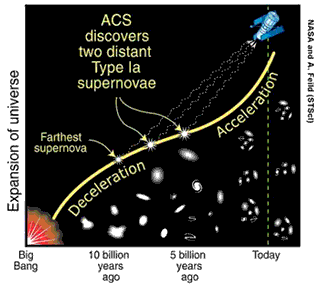 But wait, that's not all! Over the last few years observations of distant Type Ia supernovae
with the HST ACS (Advanced Camera for Surveys) have spectacularly
confirmed the initial discovery by ground-based astronomers that the
expansion of the Universe is speeding up. In their surveys of
supernovae in distant galaxies, these researchers found that the
supernovae were dimmer than they should have been, meaning they were
more distant than their redshifts would indicate. That could only be true if the expansion of the
universe had accelerated, sometime in the past.
But wait, that's not all! Over the last few years observations of distant Type Ia supernovae
with the HST ACS (Advanced Camera for Surveys) have spectacularly
confirmed the initial discovery by ground-based astronomers that the
expansion of the Universe is speeding up. In their surveys of
supernovae in distant galaxies, these researchers found that the
supernovae were dimmer than they should have been, meaning they were
more distant than their redshifts would indicate. That could only be true if the expansion of the
universe had accelerated, sometime in the past.
In addition, measurements of the Cosmic Microwave Background with NASA's MAP satellite indicate that the universe has a flat geometry on large scales. Because there is not enough matter in the universe - either ordinary or dark matter - to produce this flatness, the difference must be attributed to a "dark energy" that pervades the universe and accounts for nearly three quarters of its content. This same dark energy causes the acceleration in the expansion of the universe.
HST, WMAP, ground-based optical telescopes, and X-ray studies of
clusters of galaxies are all playing their part in providing insight
into this exotic form of energy, and NASA has plans for future
missions with even more powerful instrumentation to help us learn
more in the coming years.
The Telescope
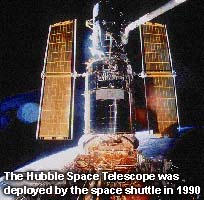 Another "quantum leap" took place in observational optical astronomy with
the launch of the Hubble Space Telescope (HST) in 1990. HST was deployed
into a low-Earth orbit by shuttle astronauts, where it could be revisited
and serviced from time to time. The telescope is named for Hubble as a
tribute to his pioneering observations. Its original design would have
given 10 times finer resolution and 50 times greater sensitivity to light
than telescopes on the ground. Unfortunately, shortly after launch, an
optical defect in the mirror was discovered. Called "spherical
aberration", it causes a blur because the mirror is not exactly the shape
it should be, but is too flat by about 1/50th the width of a human hair.
A servicing mission was quickly designed to correct the optical defect. A
scientific instrument, the High Speed Photometer, was removed from the
telescope, and replaced with COSTAR, a corrective optics package which
acted to refocus the images from the mirror. COSTAR is no longer used, as all the
new instruments contain corrective optics of their own.
Another "quantum leap" took place in observational optical astronomy with
the launch of the Hubble Space Telescope (HST) in 1990. HST was deployed
into a low-Earth orbit by shuttle astronauts, where it could be revisited
and serviced from time to time. The telescope is named for Hubble as a
tribute to his pioneering observations. Its original design would have
given 10 times finer resolution and 50 times greater sensitivity to light
than telescopes on the ground. Unfortunately, shortly after launch, an
optical defect in the mirror was discovered. Called "spherical
aberration", it causes a blur because the mirror is not exactly the shape
it should be, but is too flat by about 1/50th the width of a human hair.
A servicing mission was quickly designed to correct the optical defect. A
scientific instrument, the High Speed Photometer, was removed from the
telescope, and replaced with COSTAR, a corrective optics package which
acted to refocus the images from the mirror. COSTAR is no longer used, as all the
new instruments contain corrective optics of their own.
Current Instruments
Currently, HST is home to 4 scientific instruments. There are three cameras (WFPC2, ACS and NICMOS) and a spectrograph (STIS). WFPC2 is the Wide Field and Planetary Camera. The "2" indicates that it is second generation. ACS is the Advanced Camera for Surveys. It was built by a collaboration of the Johns Hopkins University, NASA's Goddard Space Flight Center, Ball Aerospace, and the Space Telescope Science Institute. NICMOS is the Near Infrared Camera and Multi-Object Spectrometer, observing at wavelengths longer than those detectible by the human eye. In order for its sensitive optics to be operational, NICMOS must be cyrogenically cooled. In effect, this instrument is surrounded by a really cold thermos. STIS is the Space Telescope Imaging Spectrograph. It takes two-dimensional spectra, and so it can determine chemical composition of extended objects as a function of position. is able to measure spectra from the ultraviolet through the visible to the near-infrared. On August 3, 2004, STIS stopped working due to a power loss to its electronics. It can probably only be restored to operation with physical servicing.The HST primary mirror is 2.4 meters across, and the entire observatory is about the size of a bus. The cameras record images with about 0.1 arcsecond resolution. (If you imagine a line projected on the sky from the Earth's equator, it's 360 degrees around. Each degree is made up of sixty arc minutes, and each arcminute has sixty arc seconds.) This is about ten times better than most ground-based observatories.
Hubble, Meet Dextre, Your Robotic Servant
If Hubble is not serviced by astronauts every few years, it starts to show the telltale signs of aging: the gyroscopes that allow it to point in different directions in the sky get less reliable as they age, the batteries don't charge as effectively as they used to, even some of the instruments start to break down with time. With the current spacecraft parts and instruments, Hubble may fail as soon as 2007 if something isn't done to repair it.NASA was planning a 5th servicing mission to fix Hubble. But since the Space Shuttle Columbia accident in February 2003, NASA has started thinking about how to service the Hubble without risking a human flight crew. An amazing new Canadian two-armed robot named "Dextre" may be just the ticket. Dextre was originally conceived to work on the International Space Station. Its two arms are 10 feet long, and they each can swivel, grab, reach and turn in many intricate ways. This means it may be feasible to send Dextre up into space to do all the tasks the astronauts usually do, like removing old batteries and replacing them with new ones.
But astronauts may still be involved in servicing Hubble! Because astronauts have a lot of experience handling big objects in the weightless space environment, they are the best choice to control Dextre from the ground, using a joystick.
Dextre has already passed its first audition, by showing that it could open doors, get inside a mock-up of HST and change a connector. Now the challenge is on for NASA to design a robotic mission to send Dextre to the Hubble 360 miles above the Earth. Dextre would have a lot to do once in orbit. A box that will help Hubble steer to a safe crash landing at the end of its life (a "de-orbiting module") will be attached. Six batteries need to be added. Two instruments would come off and be replaced by the Wide Field Camera 3 and the Cosmic Origins Spectrograph. Dextre may even attempt to fix the ailing Space Telescope Imaging Spectrograph.
Many scientists and engineers are excited about the prospect of a robotic servicing mission. However, a lot has to happen first to make Dextre's space adventure a reality. It may turn out that launching Dextre would cost about as much as launching a brand new telescope with the new instruments. Or, if Dextre's trip gets delayed, Hubble's batteries may run out, and it would then be too late for a robotic servicing. Lots of NASA folks are currently working on these scenarios to see whether a robotic servicing mission is in Hubble's future. We'll all need to stay tuned to see what happens!
Cool HST Science
Because of its state-of-the art cameras above the Earth's atmosphere, HST is able to collect images of objects in the universe that are as visually exciting to the general public as they are scientifically important to the scientists. Here is a short catalog of some of HST's "Greatest Hits".
- Black holes: HST's cameras are sensitive enough to peer into
the hearts of galaxies, imaging dusty hub-cap shaped disks around the
supermassive black holes that lie at their centers. These central engines
are often hundreds of millions of times more massive than the Sun.
Material spewing into them heats up and gives off tremendous radiation,
giving rise to Active Galactic Nuclei.
- Cepheids: The distance indicators so important to Hubble still
play a central role in our ability to map out the universe. Cepheids in
distance galaxies are routinely studied to get better estimates of the
size, age and total mass of the universe.
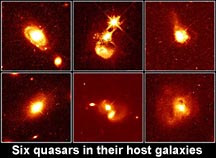
- Quasars: Among the most distant and therefore oldest objects we
can see. A typical quasar is about the size of our solar system, but puts
out as much energy as 100 to 1000 entire galaxies. Only a supermassive
black hole could account for that much energy in that small a space. HST
has resolved quasar host galaxies, showing that many quasars live at the
hearts of massive galaxies that have undergone collisions.
- Red Dwarfs: Most stars in the galaxy are dwarf stars, including
the Sun. HST has made measurements of red dwarf stars, which are only a
fraction of the mass and radius of our Sun, and found evidence for surface
magnetic fields stronger than expected. New theories of stellar interiors
for low mass stars have to be made in order to explain these HST
observations.
- Giants: Although fewer in number, giant stars make their
presence known because they are extremely bright (up to 50,000 degrees
Kelvin, compared to the Sun's surface temperature of 6000 K) and therefore
easier to spot. Giants burn the fuel in their stellar cores faster than
dwarfs. In fact, the bigger the star, the faster it is burning up, and
therefore the shorter its lifetime. Many giant stars spew material out
into space at great speeds, a phenomenon called "mass loss". And giant
stars end their normal lives with a spectacular supernova explosion.
Giants have a great effect on their neighborhoods since they are
constantly transferring material from their surfaces to the space around
them. And our theories of stellar evolution of massive stars are based
upon the careful observations of these objects. HST has made many
important observations of giant stars, most notably in our satellite
galaxies, the Large and Small Magellanic Clouds, where the incredible
resolution of HST allows us to see individual giant stars in regions that
look like bright blobs from ground-based observations.
- Fornax: A cluster of galaxies. HST is making detailed
observations of Cepheids in the galaxies in the Fornax cluster, which is
approximately 60 million light years from Earth.
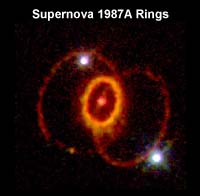
- Virgo Cluster: A cluster of galaxies that the Milky Way is
moving toward. By measuring Cepheids in the galaxies within the Virgo
cluster, HST is able to make the most accurate distance determination to
date, which is about 60 million light years from Earth.
- Supernovae: The explosive end of a massive star's life in which
the outer layers of the star are blown off into space while the core of
the star contracts to become a neutron star or black hole. In 1987 a
supernova explosion was observed in one of our satellite galaxies - the
Large Magellenic Cloud. HST images have revealed fascinating details of
this evolving stellar explosion, such as concentric bright rings and knots
as the material crashes into the surrounding gas and dust. The search for
a neutron star pulsar at the heart of this supernova is still ongoing.
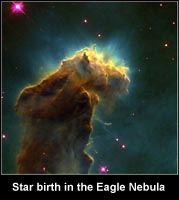
- Baby stars: HST images of the Eagle nebula reveal the striking birth of new stars emerging from evaporating gaseous globules (EGGS) in the interstellar material. Important lessons about the distribution of stellar masses, as well as the process of star birth can be learned by studying regions where the process is happening right now.
- Comets: Smallish solar system bodies that can be thought of as
"dirty snowballs". They are composed mostly of ice and dust, and are
typically in very elliptical orbits around the Sun. During HST's
lifetime, some very exciting comet events have occurred: Comet
Shoemaker-Levi 9 impacted Jupiter in a dramatic series of collisions that
were captured in vivid detail. In the Spring of 1996 comet Hyakutake
passed within 9.3 million miles of Earth displaying a blue nucleus and
long, bright tail. A year later, Spring 1997 welcomed the giant comet
Hale-Bopp, so bright it could be seen even from cities, where the sky is
never truly dark.
The centers of comets are called nuclei. Here is where gases and dust from the very earliest days of the Solar System have stayed frozen. As comets approach the Sun, material in their nuclei SUBLIMATES (goes from ice to gas without passing through a liquid phase), and measurements of its composition give us information about the composition of the early solar system. Both Hyakutake and Hale-Bopp had very active nuclei during their close approaches to the Sun, and HST observed each nucleus in detail.
The dust from a comet is affected only by gravity, while charged particles feel the effects of magnetic fields. These dueling forces have the effect of producing two distinct tails on comets.
Hale-Bopp was one of two great comets of the '90s, Hale-Bopp's nucleus is estimated to be between 19 and 25 miles across! The average comet nucleus is about 3 miles across. The comet that struck the Earth, and perhaps led to the extinction of the dinosaurs is estimated to have been between 6 and 9 miles across. Hale-Bopp could be seen for weeks in the early evening skies from many vantage points on the Earth. It was brightest on April 1, 1997. It rivals Hyakutake as the comet of the century.
- Martian Storms: HST has observed the changing face of Mars with
unprecedented detail, remotely monitoring the changing weather on Earth's
nearest neighbor.
- Hubble Constant: the number which measures the expansion rate of the universe. One of HST's key projects is to accurately determine the Hubble constant and hence the age of the universe. This key project is still ongoing, but current HST estimates by two research groups estimate that the universe is expanding at a rate between 57 and 73 kilometers per second per Megaparsec.
